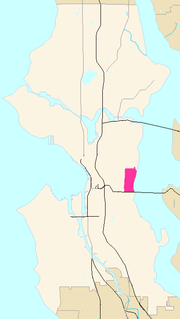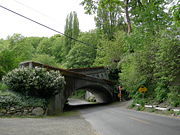
Leschi, Seattle, Washington
Encyclopedia


Leschi is a neighborhood located within the city of Seattle, Washington
Seattle, Washington
Seattle is the county seat of King County, Washington. With 608,660 residents as of the 2010 Census, Seattle is the largest city in the Northwestern United States. The Seattle metropolitan area of about 3.4 million inhabitants is the 15th largest metropolitan area in the country...
, USA. The neighborhood is named after Chief Leschi
Chief Leschi
Chief Leschi was chief of the Nisqually Native American tribe. He was hanged for murder in 1858, but exonerated in 2004.-Life:...
of the Nisqually
Nisqually (tribe)
Nisqually is a Lushootseed Native American tribe in western Washington state in the United States. The tribe lives on a reservation in the Nisqually River valley near the river delta. The Nisqually Indian Reservation, at , comprises 20.602 km² of land area on both sides of the river, in...
tribe.
Location
Leschi borders Lake WashingtonLake Washington
Lake Washington is a large freshwater lake adjacent to the city of Seattle. It is the largest lake in King County and the second largest in the state of Washington, after Lake Chelan. It is bordered by the cities of Seattle on the west, Bellevue and Kirkland on the east, Renton on the south and...
on the east; Interstate 90
Interstate 90
Interstate 90 is the longest Interstate Highway in the United States at . It is the northernmost coast-to-coast interstate, and parallels US 20 for the most part. Its western terminus is in Seattle, at Edgar Martinez Drive S. near Safeco Field and CenturyLink Field, and its eastern terminus is in...
on the south, Martin Luther King, Jr.
Martin Luther King, Jr.
Martin Luther King, Jr. was an American clergyman, activist, and prominent leader in the African-American Civil Rights Movement. He is best known for being an iconic figure in the advancement of civil rights in the United States and around the world, using nonviolent methods following the...
Way South on its west, and East Cherry Street on the north.
Homes
Residences in Leschi include condominiums (especially along the lake), refurbished bungalows and craftsman, contemporary styles, bricks, Tudors and mid-century ramblers. Curvy streets wind away from the lakefront, which means many residences get at least a partial lake view. The Seattle Post-IntelligencerSeattle Post-Intelligencer
The Seattle Post-Intelligencer is an online newspaper and former print newspaper covering Seattle, Washington, United States, and the surrounding metropolitan area...
described Leschi as "not an exclusive enclave for the rich, despite its million-dollar lakefront homes" and a "home to a racially and economically diverse group of people." The area "mix[es] stately turn-of-the century houses with far more modest homes".
There are many parks from the popular Leschi lakeside park to pocket parks spread throughout the neighborhood.
Parks
Notable neighborhood parks include Leschi Park, Frink ParkFrink Park (Seattle)
Frink Park is a 17.2 acre park in the Leschi neighborhood of Seattle, Washington. It is a heavily wooded hillside and ravine through which flows Frink Creek. Most of the park is bounded by 31st Avenue S. in the west, 34th Avenue S. in the east, and the rights-of-way of S. Main Street in the north...
, Flo Ware and Powell Barnett.
Leschi was a former campsite of Chief Leschi, of the Nisqually tribe. Chief Leschi was executed by territorial Governor Isaac Stevens for his participation in the Battle of Seattle. The 1854 treaty which took away native lands led to an attack on the settlement in 1856. Many tribe members and two settlers were killed, and Leschi was subsequently tortured and hanged. In 1889, the site became an amusement park at the end of Lake Washington Cable Railway's trolley line. The attractions included a casino, gardens, boat rentals and a zoo. The zoo animals were donated to the City in 1903 and the site itself was sold to the City in 1909 and became one of Seattle's earliest parks. Today, Leschi Park is a well-manicured, rolling hillside of grass planted with exotic trees and gardens of roses. Pathways follow an undulating terrain to restrooms above. A path to the right leads to a tennis court, and one to the left goes on up to a playground with slides and a sand box. A grassy spot under willows on the east side of Lakeside S. looks out on acres of sailboats and old-time ferry.
Since the earliest days of Seattle history, Frink Park served as a natural woodland park where city residents could enjoy mountain and sound views. Set aside as a "private" park in 1883, the main portion of the park was later purchased by John M. and Abbie H. Frink and gifted to the City on October 25, 1906. Born in Pennsylvania in 1885, John Frink attended Washington College in Topeka, and began a teaching career in Kansas. Arriving in Seattle in 1874, he both taught and served as principal at Seattle’s Belltown School. Capitalizing on the City’s growth, Mr. Frink formed a successful foundry business, Washington Iron Works. He later established the Seattle Electric company, was a director of the Seattle Savings Bank, and served as a state senator. In 1906 Mr. Frink became a member of the Board of Park Commissioners, and later its President. In 1908 the City authorized the Board of Park Commissioners to acquire additional land adjacent southeast to the park property. Other lands were given as gifts, however, the City condemned several lots just south of today’s Frink Boulevard to make room for the parkway connecting Leschi and Frink Parks. Today, Friends of Frink Park work to preserve the natural urban forest unique to the Park. These local stewards are united in ensuring the Park’s continued importance to the local residents and the city that visionaries John Frink and the Olmsted Brothers foresaw.
Flo (Florasina) Ware (1912-1981) was the quintessential activist, known in Seattle for raising a strong and logical voice on behalf of children, the elderly, and the poor. In 1982, a Seattle Parks playfield at 28th & Jackson was named in her honor. The park received a $540,000 renovation in 2002 which included art installations commemorating her life work. In recent years, it has been the site of free music events sponsored by the Leschi Community Council.
Powell Barnett Park was originally selected by the City Planning Commission as the "east Junior High School Site" and was developed as a running track and athletic field by nearby Garfield High School. Upon the acquisition and development of a playfield at the school, the "Garfield Track" was abandoned in 1962 and then sold to the Department of Parks in 1966. Playground improvements were accomplished by the community through the Central Area Motivation Program in 1967. Upon suggestion of the Leschi Improvement Council (renamed the Leschi Community Council,) in 1969, the playground was named in honor of Powell Barnett. A man of many interests and great energy, much of which was directed toward improving race relations and civic unity, Powell Barnett organized the Leschi Improvement Council and became its first president in 1967, led in organizing the East Madison YMCA, served as chairman of its board, and chaired a committee that revised the Seattle Urban League, thus saving its membership in the Community Chest. On May 19, 2006, the community, Starbucks and the City of Seattle celebrated the completion of an Ultimate Parks Makeover of Powell Barnett Park.
Businesses
Some of Leschi's more popular businesses include the Seattle famous Daniel's Broiler steak house (once home to a Ferrari dealership), BluWater Leschi, and Leschi Mart which has been family owned and operated since the end of WWII.Seattle Municipal Street Railway cable car
Between September 27, 1888, and August 10, 1940, a cable carCable car (railway)
A cable car or cable railway is a mass transit system using rail cars that are hauled by a continuously moving cable running at a constant speed. Individual cars stop and start by releasing and gripping this cable as required...
ran along Yesler Way from Pioneer Square
Pioneer Square, Seattle, Washington
Pioneer Square is a neighborhood in the southwest corner of Downtown Seattle, Washington, USA. It was once the heart of the city: Seattle's founders settled there in 1852, following a brief six-month settlement at Alki Point on the far side of Elliott Bay. The early structures in the neighborhood...
to Lake Washington. Some of the cable car tracks are still visible in certain parts of the neighborhood.
Historic photographs:
- Leschi ferry landing, 1914, from the Seattle Municipal Archives
- Seattle Municipal Street Railway cable car in Leschi Park, 1938, article at the San Francisco Cable Car Museum

